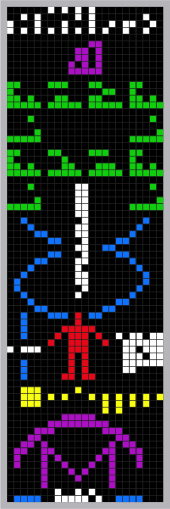Ask Ray | Fermi Paradox and the Singularity
June 9, 2011 by Ray Kurzweil

(A graphical representation of the Arecibo message, sent as radio waves into space in an attempt to communicate human existence to alien civilizations. credit: Wikipedia)
Hello Ray,
This may seem asinine but I had a thought regarding the Fermi Paradox and the Singularity. (Wikipedia: “The Fermi paradox is the apparent contradiction between high estimates of the probability of the existence of extraterrestrial civilizations and the lack of evidence for, or contact with, such civilizations.”)
As you well know there is nowhere near enough life in the galaxy (as we see it now), and almost all tool building cultures would eventually build computers.
My thought is that perhaps the Singularity already occurred on many, many worlds. And of course that’s where the model breaks down. For an endless multitude of reasons, the “other” species either stopped communicating or disappeared.
My personal theory is … species evolves tool-making skills → species designs computers → species undergoes the Singularity → species’ non-biological intelligent creations decide to take themselves and their creators to a better level of existence → species ascends.
So what do you say? Plausible or not?
— Clairette A. Chambers
Dear Clairette,
That’s the “transcension” scenario, in which post-Singularity civilizations essentially disappear by transcending space and time, or create their own universe. It’s plausible but it requires that every single civilization that develops computer technology do this. According to the common SETI interpretations (or estimates) of the Drake formula, there should be thousands or millions of these in each galaxy. That’s what seems implausible to me.
Also, there would still be remnants left behind from these civilizations that we would detect. Even if civilizations transcended “our” laws of physics, they still would have broadcast and emitted signals at a pre-Singularity stage that would still be spreading across the universe today — unless they go to a lot of trouble to clean that up. But, again, every single civilization would need to do that, which seems implausible.
Best,
Ray
About the Arecibo message
Wikipedia | The Arecibo message was broadcast into space a single time (not repeated) via frequency modulated radio wavs at a ceremony to mark the remodeling of the Arecibo radio telescope on 16 November 1974. It was aimed at the globular star cluster M13 some 25,000 light years away because M13 was a large and close collection of stars that was available in the sky at the time and place of the ceremony.
The message consisted of 1679 binary digits, approximately 210 bytes, transmitted at a frequency of 2380 MHz and modulated by shifting the frequency by 10 Hz, with a power of 1000 kW. The “ones” and “zeros” were transmitted by frequency shifting at the rate of 10 bits per second. The total broadcast was less than three minutes.
The cardinality of 1679 was chosen because it is a semiprime (the product of two prime numbers), to be arranged rectangularly as 73 rows by 23 columns. The alternative arrangement, 23 rows by 73 columns, produces jumbled nonsense. The message forms the image shown on the right, or its inverse, when translated into graphics characters and spaces.
Dr. Frank Drake, then at Cornell University and creator of the famous Drake equation, wrote the message, with help from Carl Sagan, among others. The message consists of seven parts that encode the following:
- The numbers one (1) through ten (10)
- The atomic numbers of the elements hydrogen, carbon, nitrogen, oxygen, and phosphorus, which make up deoxyribonucleic acid (DNA)
- The formulas for the sugars and bases in the nucleotides of DNA
- The number of nucleotides in DNA, and a graphic of the double helix structure of DNA
- A graphic figure of a human, the dimension (physical height) of an average man, and the human population of Earth
- A graphic of the Solar System
- A graphic of the Arecibo radio telescope and the dimension (the physical diameter) of the transmitting antenna dish
Because it will take 25,000 years for the message to reach its intended destination of stars (and an additional 25,000 years for any reply), the Arecibo message was more a demonstration of human technological achievement than a real attempt to enter into a conversation with extraterrestrials. In fact, the stars of M13 that the message was aimed at will no longer be in that location when the message arrives.
According to the Cornell News press release of November 12, 1999, the real purpose of the message was not to make contact, but to demonstrate the capabilities of newly installed equipment